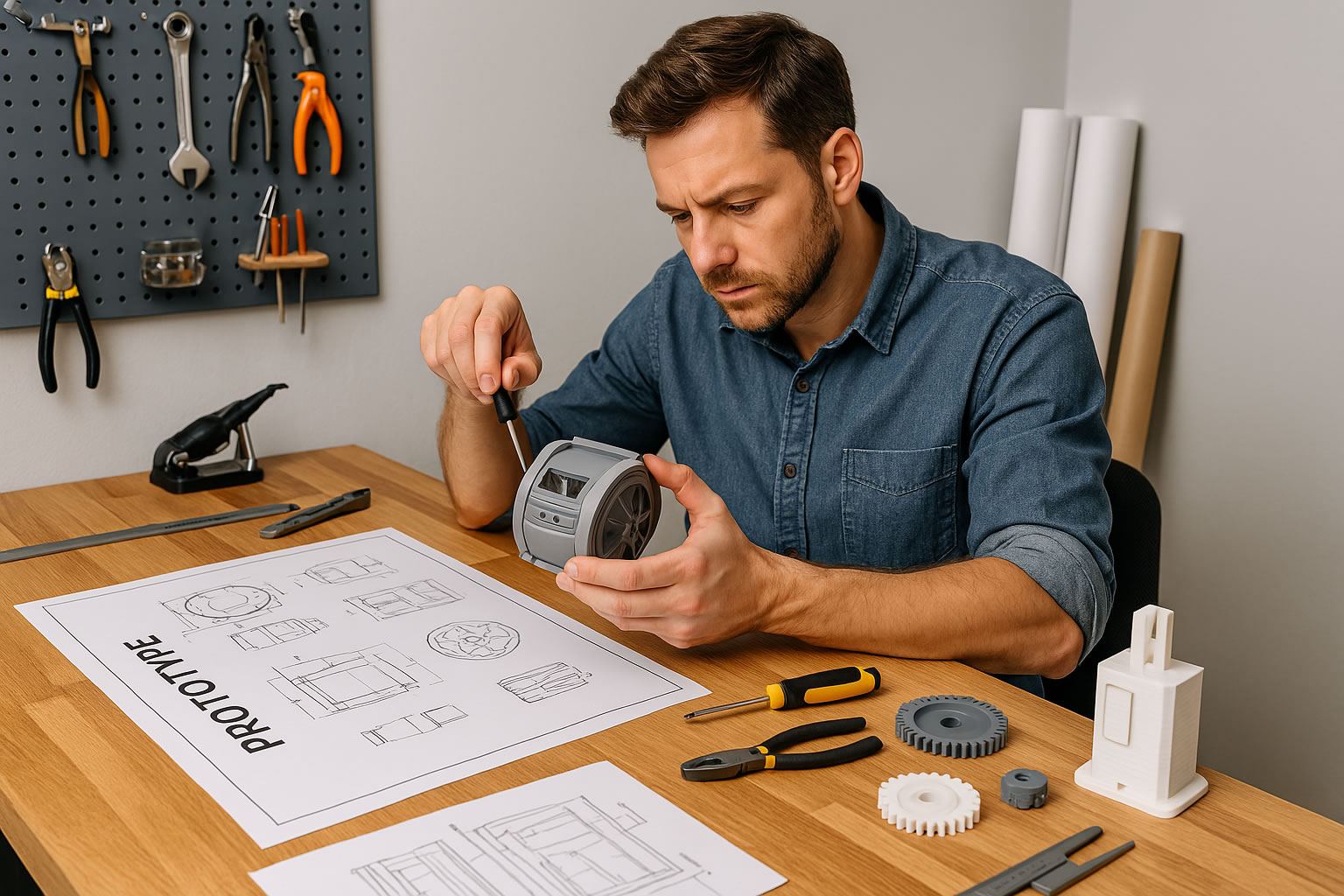Introduction
Bringing your invention to market starts with one crucial step: building a prototype. A prototype allows you to test functionality, refine design, and demonstrate your idea to investors, manufacturers, and potential licensees. However, many inventors don’t understand how to build a prototype.
This guide walks you through the entire prototyping process, from initial concept to a working model.
Step 1: Define Your Prototype’s Purpose
Before building, determine what your prototype will accomplish. Ask yourself:
- Do you need a concept model to showcase the design?
- Will a functional prototype help test mechanics and usability?
- Is a presentation prototype needed for pitching investors?
Knowing the purpose will guide materials, complexity, and cost.
Step 2: Sketch Your Idea
A detailed sketch or digital rendering helps refine your invention before physically building it. Tools to use:
- Paper & pencil for quick drafts.
- Computer-aided design (CAD) software like AutoCAD or Tinkercad.
- 3D modeling software such as SolidWorks or Fusion 360.
Sketching helps identify flaws early and communicate ideas clearly.
Step 3: Create a 3D Model or Virtual Prototype
A 3D digital model allows you to test proportions and dimensions without physical materials.
- Benefits of 3D Modeling:
- Adjust designs before physical prototyping.
- Create a blueprint for 3D printing or manufacturing.
- Best 3D Modeling Software:
- Tinkercad (beginner-friendly)
- Fusion 360 (professional-grade features)
- SketchUp (great for product visualization)
Step 4: Choose the Right Materials
The materials you select depend on cost, durability, and function. Common options include:
- Foam board or cardboard (low-cost, quick concept models).
- Plastic or acrylic (durable and moldable for functional prototypes).
- Wood or metal (for industrial-grade prototypes).
- 3D printing materials (PLA, ABS, or resin for precise models).
Step 5: Build a Basic Prototype
Start with a rough model to test form and functionality before refining.
- Use hand tools for cutting and assembling materials.
- Consider 3D printing for intricate designs.
- If necessary, hire a prototype development company.
Step 6: Test and Improve Your Prototype
After building, test the prototype thoroughly:
- Does it function as expected?
- Are there design flaws or inefficiencies?
- Can it be simplified for cost reduction?
Gather feedback from engineers, designers, and potential users, then refine your prototype accordingly.
Step 7: Develop a Production-Ready Prototype
Once testing is complete, create a finalized version that’s ready for production or licensing.
- Work with manufacturers for large-scale production.
- File a patent to protect your invention.
- Prepare a pitch presentation for investors or companies.
Conclusion
Building a prototype is a crucial step in bringing an invention to life. Whether you’re creating a basic model or a fully functional prototype, following these steps ensures a successful development process.
If you need assistance, InventionHome can help connect you with virtual prototype designers, manufacturers, and patent professionals.
Get started today with a free consultation!
How InventionHome Can Help
Bringing an invention to market can be challenging, but InventionHome simplifies the process with expert marketing and licensing services designed to connect your product with companies actively seeking new innovations. We also work with independent patent attorneys who assist with professional patent searches, filings, and legal documentation to help protect your idea.
Ready to launch and protect your invention? Get a free consultation with InventionHome today!
Frequently Asked Questions (FAQs)
How much does it cost to build a prototype?
Costs vary based on materials and complexity, ranging from $100 for simple models to $10,000+ for high-end prototypes.
Can I build a prototype myself?
Yes! Many inventors start with DIY materials before hiring a professional for advanced prototypes.
Do I need a prototype to patent my invention?
No, but having a prototype can strengthen your patent application and improve investor interest.
For more details, visit USPTO.gov.
About InventionHome
InventionHome is a trusted leader in helping everyday inventors bring their ideas to life. From patent protection and 3D virtual prototyping to product marketing and licensing, we provide the tools, expertise, and guidance to support inventors at every step. Our streamlined, affordable approach helps simplify the invention process while increasing the chances of success.
Whether you’re just starting with an idea or looking to license a finished product, InventionHome is here to help. We work with first-time inventors, seasoned innovators, and everyone in between—connecting them with companies looking for new products and opportunities. Our mission is to make inventing accessible, rewarding, and achievable.
Ready to take the next step? Email us at info@inventionhome.com or request your free consultation here to get expert help with your invention journey.
Disclaimer: This article is intended for informational purposes only and should not be construed as legal advice. While we strive to provide accurate and helpful information about the invention and patent process, InventionHome is not a law firm and does not offer legal services or legal representation. Nothing in this article should be considered a substitute for legal advice from a licensed attorney who is qualified to practice in your jurisdiction and is familiar with the specific facts of your situation. If you have questions about patent law, intellectual property rights, or the legal protection of your invention, we strongly recommend consulting with a qualified patent attorney.

